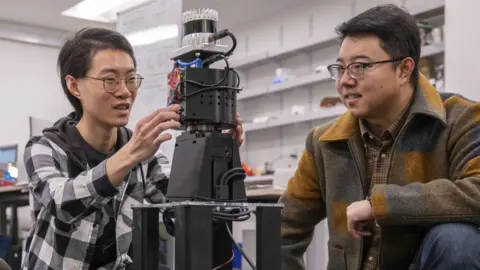 Sylvia Zhang
Sylvia ZhangIf you want to find out whether your robot can see through smoke, well, you’re going to need some smoke.
But a University of Pennsylvania student got a shock when they began setting up a late night experiment to test such a robot.
Shortly after flicking the switch on the smoke machine, a loud fire alarm went off.
“The whole building got triggered,” says Mingmin Zhao of the University of Pennsylvania, smiling. “My student called me. He was very surprised.”
The incident was a minor setback for the team developing a robot equipped with a innovative radio-based sensing system.
Radio waves could allow robots or autonomous vehicles to see through thick smoke, intense rain – or even around corners. Such waves can even detect concealed weapons.
But simulating visual imagery based on radio waves is an unusual approach for robots and autonomous vehicles. Much more established in those fields are regular optical cameras, light detection and ranging (Lidar), and other sensors.
However, Prof Zhao and his students have developed a potentially powerful way for robots to see using radio waves.
Of course radar, which uses radio waves, has been used for decades to track aircraft, ships and the weather.
But the spinning array on Prof Zhao’s robot throws radio waves in all directions.
An on-board artificial intelligence (AI) system then builds a 3D view of the environment with this information.
“What we have been trying to do here is basically help robots obtain superhuman vision – to see in scenarios where human eyes or traditional visual sensors cannot,” explains Prof Zhao.
He suggests the technology could help a future search-and-rescue robot save people from a burning building.
Subsequent tests of the bot used a clear plastic box full of smoke placed around the its spinning equipment, in order to avoid triggering any nearby fire alarms.
